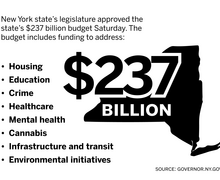Professors use crowdfunding to help restore American chestnut trees
Tony Chao | Art Director
After 25 years of work, two SUNY-ESF professors have developed a way to restore the American chestnut tree back to its former glory and are receiving funding from the community to help the cause.
The American chestnut tree was almost wiped out due to a blight but William Powell and Chuck Maynard of the State University of New York College of Environmental Science and Forestry have found a way to create blight-resistant trees. Their goal is to produce 10,000 trees while going through the regulatory process. Normal grant agencies won’t help with funding as it is not considered research though, which is why they turned to a crowd funding page that has received more than $35,000 in support so far.
“I always tell people that we can’t build the boat before we went fishing”, said Powell about the process behind the creation of the tree.
The American chestnut tree used to be the most common tree in the eastern forest until about a century ago when people started importing Asian chestnut trees. When brought over, the Asian chestnut trees also brought a blight, which produces an acid called oxalate. Oxalate acid invades healthy tissue in the tree and creates a canker — a sunken dead area of the tissue on the bark. This grows around the tree and essentially cuts off circulation so that everything above it dies.
While the Asian chestnut trees were resistant to it, the American chestnut trees were not. It started in Long Island and over the course of about 50 years spread through the whole native range from Maine to Georgia, killing three to four billion large American chestnut trees.
Maynard and Powell had to start from scratch as no one had ever regenerated an American chestnut tree from tissue culture before. The process was complex, Powell said. The researchers had to develop the tissue culture methods, find the gene for blight-resistant trees and then actually create the blight-resistant tree. This tree is particularly important as many different organisms depend on the American chestnut tree and bringing it back will benefit the forest.
This is the first time that genetic engineering has been used for environmental purposes, though it has been used for years in medical and agricultural fields.
While Powell and Maynard have developed the blight-resistant chestnut tree, they cannot immediately start distributing them as they still have to go through the Federal regulatory process because they used genetic engineering. While the regulatory process may take several years, Maynard and Powell are creating trees so that they will be ready for immediate dispersal once they have been approved.
“While we’re waiting, we didn’t want to sit on our hands, we want to actually produce,” Powell said.
Dana Piwinski, a development officer at SUNY-ESF, said he is very happy about the support that the Fundly page set up for the restoration has gotten from both alumni and strangers.
“People will post comments about how their grandmother used to tell them about the big chestnut trees in their yards, and they’re excited about seeing them again in the future,” Piwinski said. “There is a lot of popular sentiment for the chestnut tree.”
Through the Fundly page, the researchers are hoping to garner interest in people across the country to become part of the project and support it in two ways: funding to help them grow the trees, as well as participate in planting of the mother chestnut trees that the blight-resistant trees could be used to breed with in the future, once they’re available. The page has been getting traffic and after only one week, half of the $50,000 goal has been raised.
Powell said that the main reason to focus on this tree for so long is because of its importance to the environment and its history.
“The American chestnut is ingrained into our history, and we need to get it back,” he said. “This time of year when you hear ‘chestnuts roasting on an open fire.’ That’s talking about the American chestnut.”
Published on November 18, 2014 at 12:01 am
Contact Anjali: acalwis@syr.edu




